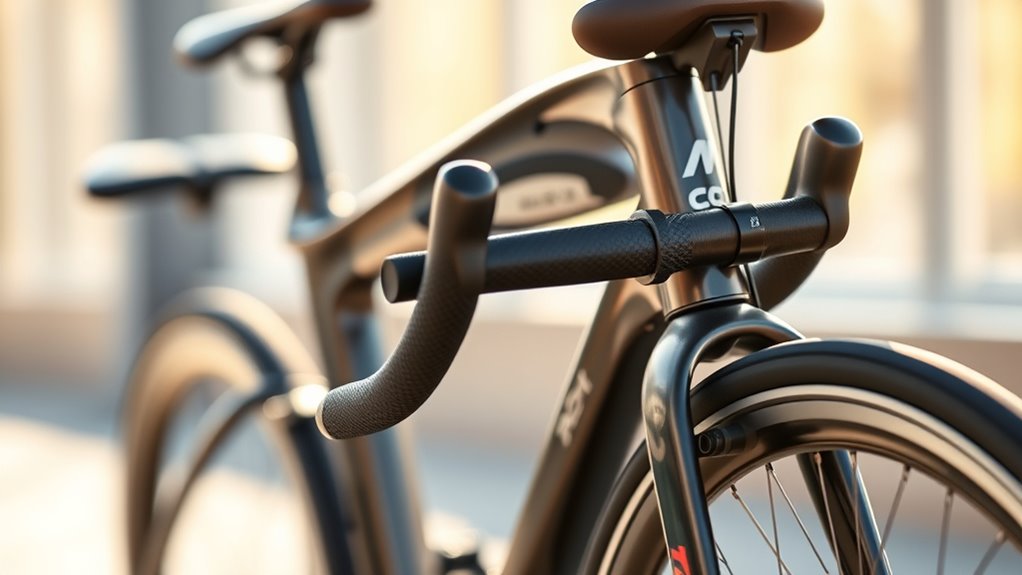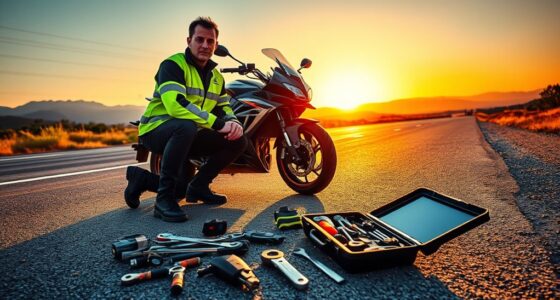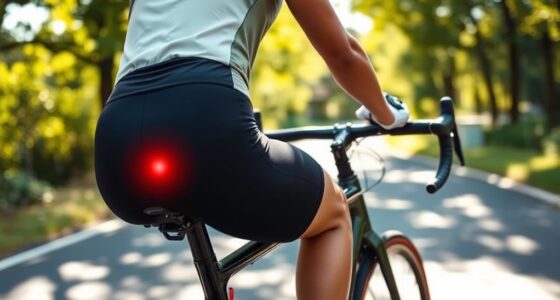Design innovations in adaptive cycling equipment focus on personalized motor assistance, enhanced safety, and accessibility. You’ll find technologies like advanced sensors, real-time feedback, and customizable controls that adapt to your needs. Modular frames and stability-enhanced structures make riding easier and safer for diverse users. Off-road upgrades and durable materials improve performance on rugged terrain. Exploring more reveals how these advancements are shaping inclusive, efficient cycling solutions tailored just for you.
Key Takeaways
- Integration of real-time feedback systems and adaptive algorithms personalizes riding experiences and optimizes performance across terrains.
- Modular and customizable designs enable easy adaptation for diverse user needs, including various disabilities and preferences.
- Advanced motor assistance with regenerative charging enhances energy efficiency and seamless, natural pedaling support.
- Stability-driven structures like low-center-of-gravity recumbent trikes and wide tires improve safety and off-road capability.
- Collaboration with industry and academia accelerates innovation through rapid prototyping, lightweight materials, and open-source design sharing.
Advanced Motor Assistance Technologies
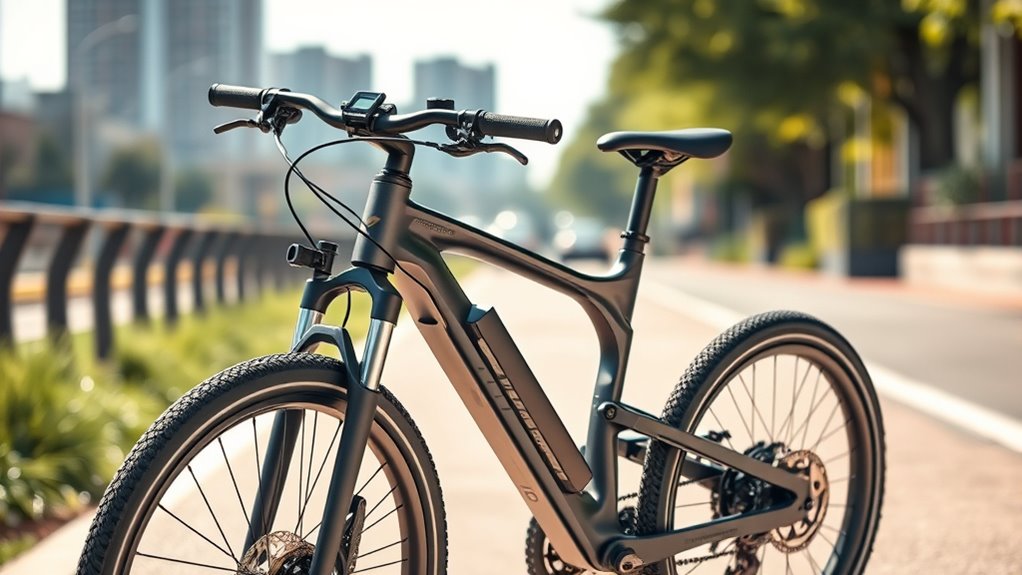
Advanced motor assistance technologies have transformed the cycling experience by providing powerful, smooth support that adapts to your riding needs. The Giant E+ System offers up to 400% additional pedaling support, making pedaling easier and more efficient. With SyncDrive technology, assistance syncs seamlessly with your pedaling, delivering a natural feel. These systems use advanced batteries and motor designs that boost energy efficiency, helping you travel farther and faster with less effort. Many include auto assist modes that automatically adjust power based on terrain and rider input, optimizing comfort and performance. Some systems even feature regenerative charging, capturing kinetic energy to extend battery life. Additionally, motor technology plays a crucial role in enhancing overall ride quality and efficiency. The integration of adaptive support systems creates a responsive, effortless ride, letting you focus on the joy of cycling while technology handles the support. Incorporating user feedback ensures these systems continually improve and adapt to rider preferences and conditions. Moreover, ongoing innovations in battery technology are increasing the range and longevity of electric assist systems, making them more reliable for extended rides. Furthermore, advancements in sensor integration enable more precise adjustments to support, improving rider comfort and control.
Enhanced Accessibility Features for Diverse Users
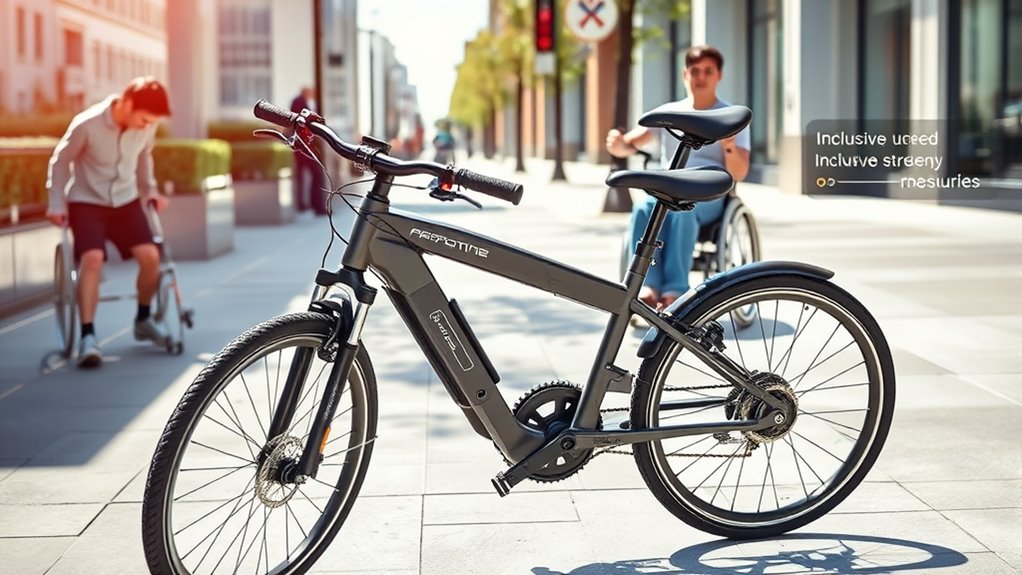
To guarantee that cycling is accessible for everyone, manufacturers have integrated a range of features designed to accommodate diverse abilities. You’ll find low step-through frames that make mounting and dismounting easier, especially for those with mobility issues. Necessary cookies ensure that these features function smoothly and securely. Attachable handcycles connect seamlessly to wheelchairs, eliminating transfer needs. Three-wheeled designs provide stability, reducing fall risks for balance-challenged riders. Sensory-friendly options with gentle materials and colors cater to individuals with autism or sensory sensitivities. Modular components allow you to customize your bike based on your specific needs, ensuring a comfortable, secure ride. Enhanced seating, including adjustable, ergonomic seats with back support and comfort accessories, boosts comfort during longer rides. Secured foot mechanisms and adaptive control systems also help you ride safely, confidently, regardless of mobility or sensory challenges. Incorporating adaptive technology further enhances riding safety and independence for users with varying needs. Additionally, integrating AI-powered assistive features can optimize the riding experience by providing real-time adjustments and feedback tailored to individual user requirements. Moreover, advanced safety features such as reflective surfaces and integrated lighting help increase visibility and safety during rides in low-light conditions.
Stability-Driven Structural Designs
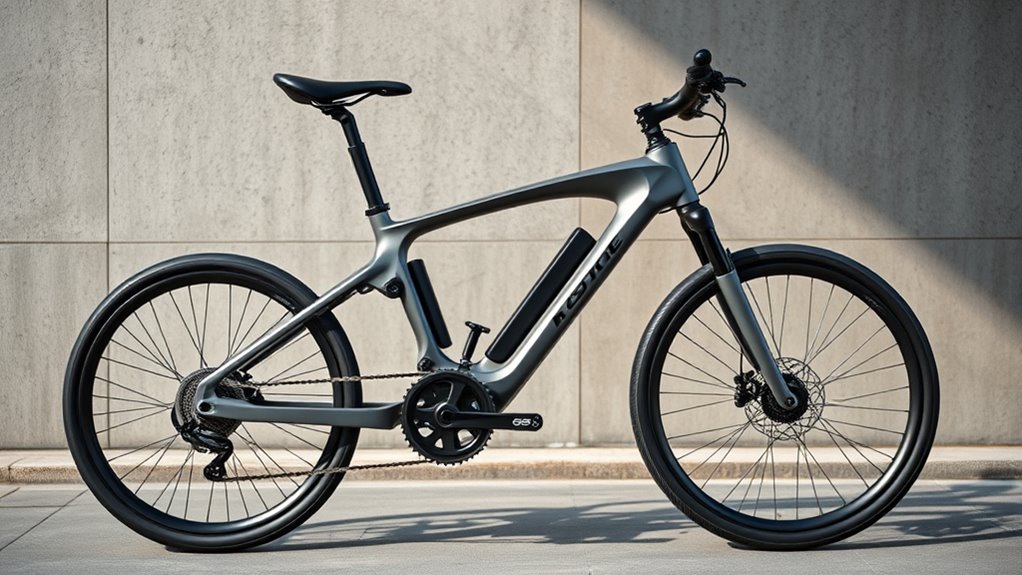
Stability-driven structural designs are essential for guaranteeing safe and confident riding, especially for users with mobility challenges or beginners. Recumbent trikes, with their reclined seating and low center of gravity, enhance ergonomics and balance. The tadpole configuration, with two front wheels and one rear wheel, provides superior stability and control on varied terrains. Wheelbase arrangements can be adjusted for agility or steadiness, while suspension systems absorb shocks to maintain balance. Proper weight distribution ensures even stability during movement. Wide wheel treads improve traction, and adjustable seat angles help optimize rider positioning. Incorporating balance and control features is crucial for enhancing rider confidence and safety. Additionally, structural integrity plays a vital role in durability and long-term performance. Designing frames with robust materials further ensures resilience under different riding conditions. Incorporating advanced manufacturing techniques can also improve the precision and strength of the structural components. Safety features like reliable brakes, foot restraints, and visibility enhancements further support safe riding. These structural innovations create a stable, secure experience tailored to diverse needs and environments.
Customizable Components for Personalized Fit

Customizable components enable you to tailor your cycling equipment to fit your unique body and riding needs. You can modify frames for different sizes or disabilities, guaranteeing comfort and efficiency. Materials like carbon fiber keep the bike lightweight yet durable, enhancing performance. Modular designs let you add or remove parts based on your specific requirements, making upgrades simple. Ergonomic construction reduces strain by accommodating natural seating and pedaling positions. You can also integrate accessories such as specialized pedals or seats to suit your preferences. Adjustable handlebars and seats allow you to find the perfect fit, while grip sizes can be customized for better control. These features ensure your bike adapts seamlessly to your body, promoting a more comfortable and personalized riding experience. Incorporating Best Modern Toilet features into your cycling space can enhance overall hygiene and convenience. Additionally, the availability of Unique and Wicked Planters and other innovative accessories can create a more enjoyable and functional environment around your cycling area. Exploring sound healing science in your training routine may also help improve focus and mental clarity during rides. Moreover, proper fit adjustments are essential to prevent strain and maximize efficiency during each ride, ensuring long-term comfort and performance.
Off-Road Performance and Durability Upgrades
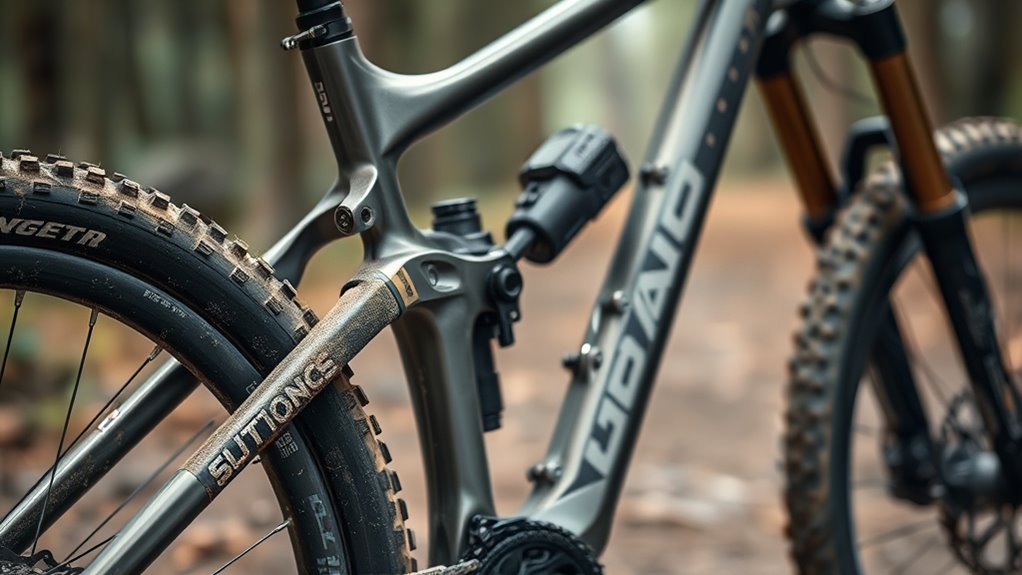
Building on the personalized fit offered by customizable components, off-road cycling equipment now incorporates a range of performance and durability upgrades designed for rugged terrains. You’ll notice wider, more durable tires that grip tough surfaces and handle rough terrain confidently. Inflating Presta Valve Tires is essential for maintaining optimal tire pressure and ensuring reliable performance on challenging trails. Electric assist options give you extra power on steep or challenging trails, making climbs easier. Advanced braking systems, including reverse brakes, improve safety and control in unpredictable conditions. The Bowhead Reach’s articulating front end enhances maneuverability without adding width, boosting stability. Premium suspension systems from brands like FOX and RockShox ensure a smooth ride over uneven ground. Rugged materials and handcrafted designs increase durability, while features like enduro bearings reduce maintenance needs. These upgrades make off-road riding safer, more reliable, and accessible across diverse outdoor environments.
Incorporating Feedback and Data-Driven Adjustments
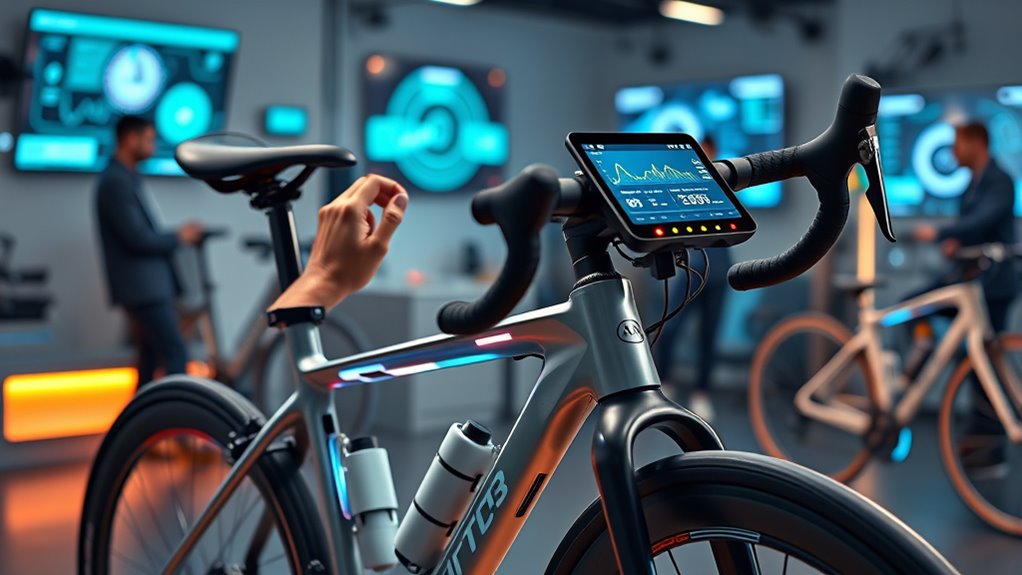
Incorporating feedback and data-driven adjustments into adaptive cycling equipment allows you to tailor your experience for maximum efficiency and comfort. Adaptive pedals and controls are highly customizable, accommodating varying leg mobility levels. Real-time feedback systems, like handlebar displays and mobile device integrations, help you monitor speed, heart rate, and performance, enabling immediate adjustments. Haptic and audio cues provide tactile and auditory feedback, keeping you informed without distraction. Advanced algorithms, such as PID and MPC controllers, optimize pacing and riding strategies based on terrain and weather conditions. Many systems are cross-platform compatible and integrate with fitness apps, giving you a thorough view of your performance. Sensor technology plays a crucial role in gathering accurate data to enhance adaptive responses and personalization. Additionally, the integration of trustworthy brands ensures the reliability and safety of the equipment used. Implementing these innovations can lead to improved cycling efficiency and a more personalized riding experience. This combination of data and feedback ensures your ride is efficient, comfortable, and aligned with your personal goals.
Collaborative Innovations and Open-Source Contributions
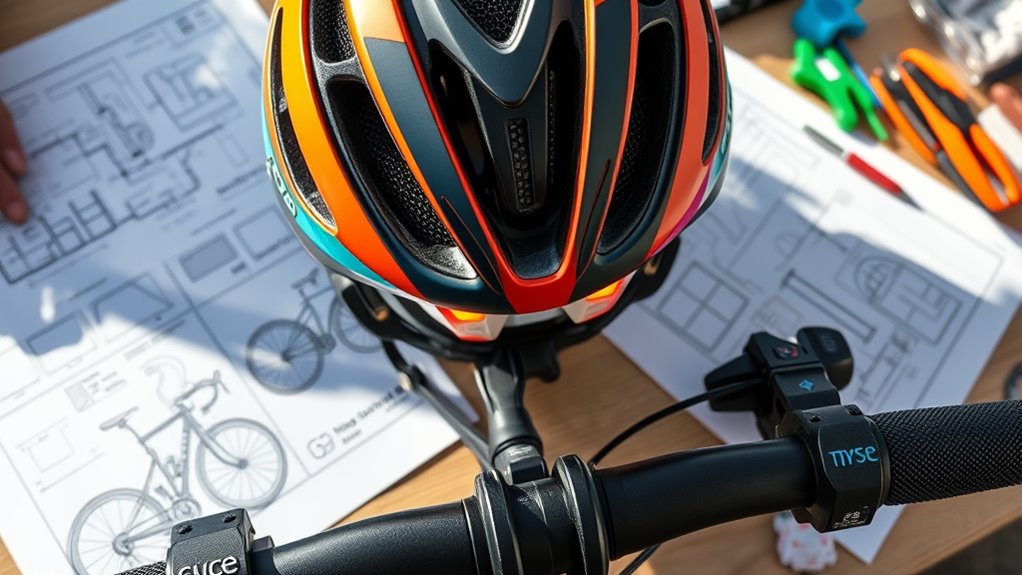
Collaborative innovations and open-source contributions are transforming adaptive cycling by fostering a global community dedicated to continuous improvement. You benefit from university partnerships, like the University of Colorado’s work with local organizations, which develop lightweight, user-centered bikes.
Collaborative efforts and open-source innovation drive continuous improvement in adaptive cycling.
Industry collaborations with SRAM and 3D Systems provide essential support for materials and prototyping. Open-source blueprints are shared publicly, enabling worldwide replication and iterative upgrades, while modular designs reduce costs and promote compatibility.
Community involvement, including external engineers, drives ongoing innovation. Documentation ensures users can assemble and troubleshoot their equipment easily. Athletes participate in needs assessments, guiding ergonomic and safety features.
Rapid prototyping with 3D printing and recycled materials accelerates development. These efforts increase accessibility, making adaptive bikes more affordable and customizable for diverse users.
Frequently Asked Questions
How Do Adaptive Cycling Systems Accommodate Users With Severe Physical Disabilities?
You want to understand how adaptive cycling systems support users with severe physical disabilities. These systems feature specialized frames with three wheels and wider bases to improve stability.
They include customizable seats, supports, and harnesses to guarantee proper positioning.
Alternative propulsion options like electric motors or hand-driven pedals make riding easier.
Safety features such as automatic brakes and anti-tip wheels help prevent accidents, allowing you to enjoy cycling with greater independence and confidence.
What Safety Standards Are Integrated Into Advanced Adaptive Cycling Designs?
You need to know that advanced adaptive cycling designs incorporate safety standards like reflectors and flags for visibility, and approved helmets for protection.
They also feature stability aids like gravity dampers and custom leg supports to prevent tipping and improve control.
Clear communication between you and support volunteers is essential, along with secure pedal attachments and effective braking.
These standards guarantee your safety and confidence during rides.
Can Customization Options Be Tailored for Specific Medical Conditions or Therapy Goals?
Imagine crafting a suit perfectly tailored to fit your unique shape and needs. That’s exactly what customization in adaptive cycling does. You can have bikes adjusted for specific medical conditions or therapy goals, like adding support or modifying controls.
This personalized approach guarantees you get the right fit, boosting comfort, safety, and effectiveness, so you can focus on enjoying your ride and reaching your rehabilitation or fitness goals.
How Are Adaptive Bikes Tested for Long-Term Durability and Reliability?
You test adaptive bikes for long-term durability by subjecting them to repetitive load cycles that simulate years of use. You evaluate their ability to withstand stresses through high-cycle fatigue tests, often reaching 100,000 cycles at different stress levels.
You also consider environmental factors like corrosion and perform real-world simulations.
Regular rider feedback and long-term usage studies help guarantee these bikes remain reliable and safe over time.
What Funding or Subsidy Opportunities Exist for Acquiring Adaptive Cycling Equipment?
You want to know about funding for adaptive bikes, and there are many options to explore. You can seek insurance coverage, especially with premium plans, or get government grants through Medicare, Medicaid, or VA programs.
Charitable foundations like CAF and Kelly Brush also offer grants. Community programs, crowdfunding, and manufacturer partnerships can help as well.
Actively pursue these resources, and you’ll find support to make adaptive cycling accessible and affordable for you.
Conclusion
So, with all these shiny new gadgets, your bike’s practically a spaceship. You’ll pedal smoother, faster, and look cooler than ever—because who needs simplicity when you’ve got high-tech? Whether you’re conquering rough trails or just rolling through town, these innovations promise a ride tailored just for you. Just remember, the more you upgrade, the less likely you’ll ever want to pedal without tech—because why settle for ordinary when you can have extraordinary?
